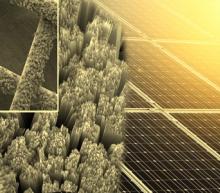October 20, 2014 – A recent edition of the journal Nature Communications, includes an article entitled, Integrating a redox-coupled dye-sensitized photoelectrode into a lithium–oxygen battery for photo-assisted charging, which when the meaning gets distilled is describing the combining of battery and photovoltaic cell into a single device.
Developed at The Ohio State University, the plan is to license the hybrid device for commercial development and distribution. Yiying Wu, Mingzhe You and Xiaodi Ren describe their invention as “a unique strategy” that integrates solar photovoltaic cells with a battery. The device improves solar energy performance by 25% over current technology, capturing nearly 100% of all the electrons emerging from the photovoltaic cell.
The design uses a titanium dye-sensitized mesh coated with iron oxide (rust) upon which titanium dioxide blades are grown. The dye sensitized mesh is tuned to capture a broad spectrum of light. Air passes through the mesh but light is captured. Beneath the mesh are a number of additional layers of material. One is a sheet of porous carbon and another is a lithium peroxide plate. The mesh, carbon and lithium form three electrodes. Between each the inventors put layers of electrolytes containing an iodide additive to provide a highly efficient method of transport for electrons.
The composite image below shows the solar cells to the right and two microscopic views , the larger one, of the blades of titanium dioxide and the smaller inset the gauze mesh.
When sunlight strikes the gauze mesh and titanium blades, electrons get produced. They in turn interact with the carbon and lithium peroxide. The chemical reaction creates ions and oxygen and converts the lithium peroxide plate into lithium metal storing the electrons in the process. Oxygen, the byproduct, is released. When the device discharges the lithium metal interacts with oxygen to reform lithium peroxide and free the electrons and voila, you have a solar cell that doubles as a solar battery.
Is this a big deal? You bet. For solar energy it could be the answer to continuous power generation day and night, 24 x 7. When the sun is shining the energy produced will power homes and businesses. And when the sun is not the battery will discharge the excess electrons to power those same structures.
The race to create more efficient solar energy conversion technology has never gotten more interesting. A number of companies and universities are beginning to reveal significant innovation with breakthroughs announced, it seems, every other month. The advances in thin-film deposition and nanotechnology plus our better understanding of the electrolytic properties of various materials is helping to move us closer to harvesting the energy that powers the Earth, our Sun.
The developers at Ohio State are among those leading the pack. They recently won a $100,000 US clean energy prize for inventing a high-efficiency air-powered battery using chemically treated potassium with oxygen. Now with their solar battery they have upped the game and created a technology that may soon spread to rooftops everywhere on the planet.













